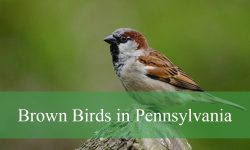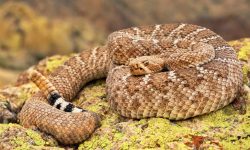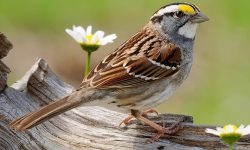In the vast avian kingdom, a diverse array of small birds captivate with their unique charm and distinctive features. Among this enchanting avifauna, a notable group stands out—those adorned with long beaks. These specialized bills serve a variety of purposes, from foraging for insects to sipping nectar from flowers.
Let’s embark on a journey to explore 25 small birds with long beaks, each contributing its own intriguing characteristics to the fascinating tapestry of the bird world.
Different Types of Small Birds With Long Beaks
Sword-billed Hummingbird
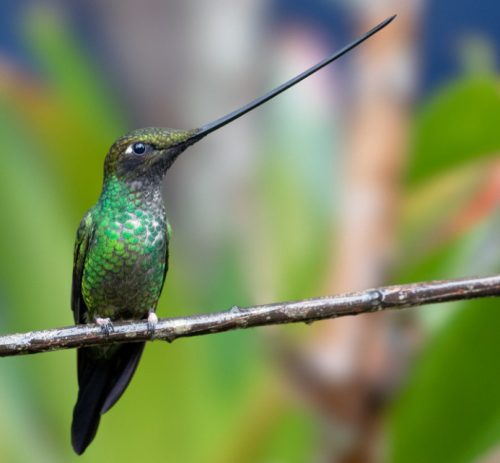
The Sword-billed Hummingbird, scientifically named Ensifera ensifera, is categorized as “Least Concern” in terms of conservation status. Standing out with its exceptional beak length, this hummingbird is dark in color, relatively heavy, and exhibits a slight upward curve in its beak.
Remarkably, the Sword-billed Hummingbird’s beak is longer than its entire body, even when excluding the tail. This distinctive feature enables them to access flowers with long corollas, which would be unreachable by other animals. The species plays a crucial role in the pollination of numerous plant species, both wild and cultivated. Their specialized beaks are essential for pollinating flowers with lengthy corollas, ensuring the survival of these plants.
These birds, with a lifespan of up to 8 years, are found inhabiting the Andes, spanning from western Venezuela through Colombia, Ecuador, Peru, and Bolivia.
Bewick’s Wren
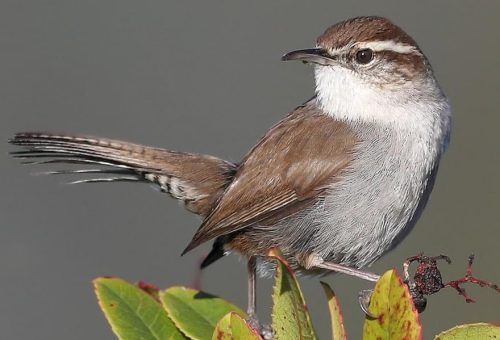
The Bewick’s Wren, scientifically known as Thryomanes bewickii, holds a conservation status of “Least Concern” and is a small, long-beaked bird widely distributed across most of the United States. With a length ranging from 5.1 to 5.5 inches (13–14 cm) and a weight of 0.3–0.4 ounces (8–12 g), these wrens boast a distinctive appearance. They feature a brown head with white undersides and a prominent long white brow.
Easily identifiable by their long, black-barred tail with white edges, Bewick’s Wrens are known for the constant movements of their tails, which draw attention. These birds exhibit skilled foraging behaviors, primarily feeding on insects by scavenging foliage, including tree trunks, for insects and their eggs. Impressively, they swiftly kill and wholly swallow the insects they capture.
In addition to their foraging prowess, Bewick’s Wrens are adept vocalists, utilizing a diverse range of short whistles, warbles, burrs, and trills for various purposes. These vocalizations serve functions such as courtship displays for potential partners, warning signals to deter predators, and expressing disapproval towards unwanted guests.
In the western part of North America, Bewick’s Wrens are often found in arid, dense, or scrubby areas. They have a potential lifespan of up to 8 years.
Cactus Wren
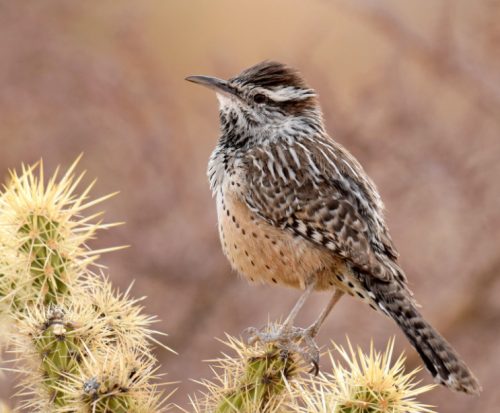
The Cactus Wren, scientifically identified as Campylorhynchus brunneicapillus, holds a conservation status of “Least Concern” and boasts distinctive physical characteristics. With a length ranging from 7 to 7.5 inches (18–19 cm) and a weight of 1.2–1.6 ounces (33–47 g), this small, brown bird features a noteworthy wingspan of 10.6–11 inches (27–28 cm) and has a potential lifespan of up to 7 years.
The Cactus Wren, recognized as Arizona’s official bird, stands as the largest wren species in the country. Found not only in Arizona but also in other locations, these birds exhibit an active lifestyle, whether seen hopping on the ground, fanning their tails, or singing from the tops of cacti.
Their vocalizations are characterized by a rough, scratchy sound reminiscent of someone attempting to start a car, a distinctive feature observed throughout the day. Hardy and resilient, Cactus Wrens thrive in desert environments, showcasing their ability to survive without a standing water source. This adaptation has earned them the reputation of being the quintessential desert bird of the American Southwest.
You can find these small, brown birds with long bills in the arid regions of the southwestern United States and central Mexico.
Canyon Wren
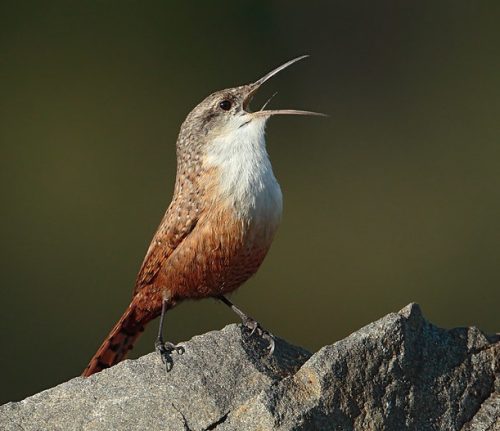
The Canyon Wren, scientifically named Catherpes mexicanus, is designated as “Least Concern” in terms of conservation status, embodying unique characteristics. With a length spanning from 4.3 to 6 inches (11–15 cm) and a weight ranging between 0.3 and 0.6 ounces (10–18 g), these small birds feature a wingspan of 7.1–7.9 inches (18–20 cm) and have a relatively short lifespan of up to 2 years.
What distinguishes the Canyon Wren is not only its size and appearance but also its remarkable vocal abilities. Possessing a long beak and a melodious voice, their song is a captivating series of lovely, cascading whistles that resonate against the canyon walls. This distinctive vocalization not only draws the attention of birdwatchers but also captures the interest of music enthusiasts.
Known for their nimbleness, Canyon Wrens predominantly forage for insects in rocky areas. Their agility allows them to scale cliff walls with ease, and they exhibit surgical precision in probing into cracks using their long, thin beaks. The falling succession of whistles produced by Canyon Wrens is a recognizable bird cry echoing through the rocky canyons of the western United States.
Carolina Wrens
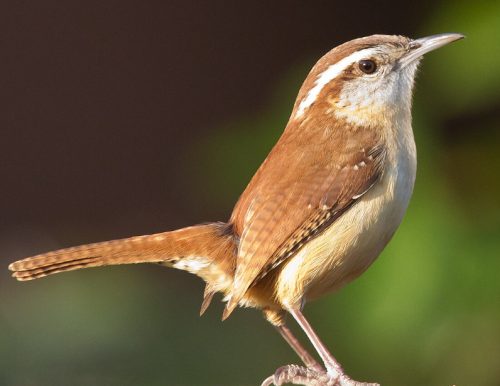
Carolina Wrens, scientifically known as Thryothorus ludovicianus, is designated as a species of “Least Concern” in terms of conservation status. Measuring 5 to 5.5 inches (12.5–14 cm) in length and weighing 0.6–0.8 ounces (18–23 g), these birds have a wingspan of 9.4–11, 4 inches (24–29 cm) and can potentially live up to 10 years.
Carolina Wren have lively plumage and melodious voices, and their small size makes them difficult to detect compared to other wrens. Surprisingly, few larger birds can match the power of sound produced by this small, long-billed bird.
Throughout the day, Carolina Wrens engage in foraging activities close to the ground, hiding in bushes and vines. Their foraging habits include leaf litter scavenging and insect probing, as well as checking for cracks in the bark of lower tree levels.
Thriving in habitats with dense vegetation, Carolina Wrens are commonly found in forests, along farm boundaries, and in suburban areas. The Carolina Wren is considered the official bird of South Carolina. Although they occur primarily in South Carolina, their range extends into eastern South America, the southernmost part of Ontario, Canada, and the northeastern part of Mexico.
Winter Wren
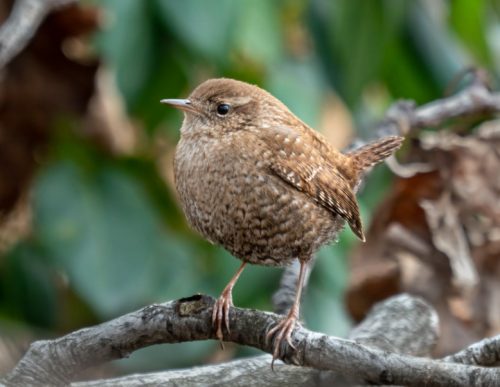
The Winter Wren, scientifically known as Troglodytes hiemalis, is categorized as “Least Concern” in terms of conservation status. This diminutive bird is native to the northern parts of America and belongs to the predominantly new world wren family Troglodytidae. Notably, Winter Wrens are characterized by their small size and long, skinny beaks.
Featuring predominantly brown plumage adorned with dark bars on their wings, tail, and underside, Winter Wrens exhibit distinctive behaviors. They are known for their regular bouncing motion, holding their small tails in a rigid position. Running and hopping around fallen logs like mice, they actively search for insects in the exposed roots and plants.
During the summer months, Winter Wrens thrive in evergreen forests with abundant fallen logs and deep understories near streams. However, as winter approaches, they shift out of dense forests and into semi-open habitats or younger, moist woodlands, exposing themselves more prominently.
These adaptable birds inhabit Arctic regions across North America, Europe, Asia, and Arctic Ocean islands. With a length ranging from 3.1 to 4.7 inches (8–12 cm), a weight of 0.3–0.4 ounces (8–12 g), and a wingspan of 4.7–6.3 inches (12–16 cm), Winter Wrens have a potential lifespan of up to 7 years.
Marsh Wren
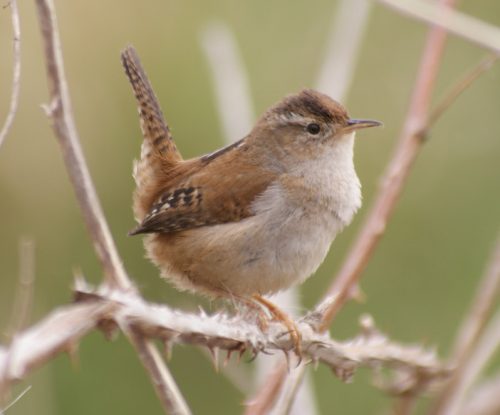
The Marsh Wren, scientifically identified as Cistothorus palustris, is categorized as “Least Concern” in terms of conservation status, standing out as the smallest member in the wren family of North American birds. Distinguished by its long beak, the Marsh Wren sets itself apart from its close relative, the Sedge Wren, sometimes referred to as the short-billed marsh wren.
Featuring rusty-brown plumage streaked with black and white, along with white eyebrows, these diminutive birds possess a surprising level of assertiveness. In their quest for food and shelter, Marsh Wrens exhibit aggressive behavior, often penetrating the eggs of other birds and consuming their young. Their diet primarily consists of insects, spiders, and snails.
For successful nesting, Marsh Wrens require tall vegetation, specifically cattails and bulrush. These provide the necessary structure and cover for their nesting activities. Throughout North America, Marsh Wrens are prevalent, spending the colder months in the brushy margins of ponds, freshwater and saltwater marshes, and other bodies of water. With a length ranging from 3.9 to 5.5 inches (10–14 cm), a weight of 0.3–0.5 ounces (8.5–14.2 g), and a wingspan of 5.7–6 inches (14–15.2 cm), Marsh Wrens boast a potential lifespan of up to 9 years.
Rock Wren
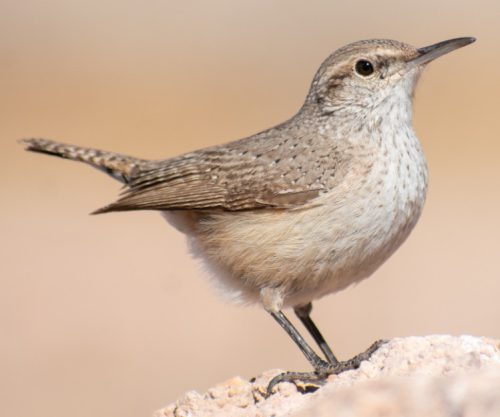
The Rock Wren, scientifically classified as Salpinctes obsoletus, holds a conservation status of “Least Concern” and is characterized by its small size and long beak. Inhabiting dry, rocky canyons and formations of boulders, the Rock Wren adapts seamlessly to environments that may initially appear barren.
Notably, these wrens construct their nests using small, flat stones or pebbles, often hidden in cracks or crevices amongst the rocks. Their adeptness at navigating rocky terrain is evident as they continuously hop around, diligently searching for bugs and spiders in the cracks using their thin bills.
Remarkably adaptable, Rock Wrens thrive in changing environments, particularly in deserts where few other bird species can persist. They exhibit a preference for slopes with sparse vegetation, numerous cracks, and some shade, showcasing their ability to make a home in diverse landscapes.
A distinctive habitat for Rock Wrens includes the restored Mayan and Aztec ruins of Mexico and Central America, where the arid conditions suit their preferences. With a length ranging from 4.9 to 5.9 inches (12.5–15 cm), a weight of 0.5–0.6 ounces (15–18 g), and a wingspan of 8.7–9.4 inches (22–24 cm), Rock Wrens have a potential lifespan of up to 5 years.
House Wren
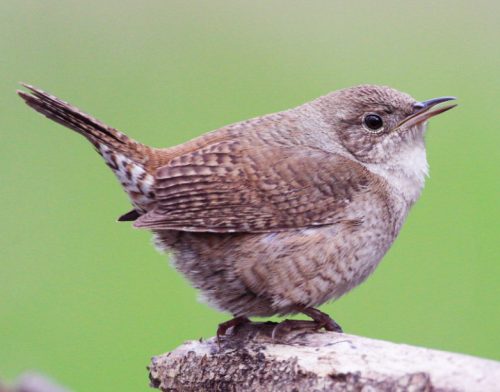
The House Wren, scientifically known as Troglodytes aedo, is classified as “Least Concern” in terms of conservation status. Recognized for its common presence, this bird, characterized by a long beak, has earned its name due to its inclination to nest near or within birdhouses.
During the nesting season, the House Wren is known for its rich, bubbly song, a distinctive feature that becomes less audible once the season concludes. Despite their modest coloring, House Wrens contribute vibrant energy to gardens and metropolitan parks, characterized by their lively movements and the distinctive sight of their short tails raised high.
The House Wren encompasses several subspecies, and its geographic range spans from central Canada to southern South America. Contrary to their common name, House Wrens are not exclusively associated with human habitation. They display adaptability to diverse natural settings, including open woods, woodlands, dense bushes, valleys, and orchards.
With a length ranging from 4.3 to 5.1 inches (11–13 cm), a weight of 0.3–0.4 ounces (10–12 g), and a wingspan of 6–6.3 inches (15–16 cm), House Wrens have a potential lifespan of up to 7 years. Their ability to thrive in various environments, coupled with their lively presence, makes them a notable and widespread species across the Americas.
Sedge Warbler
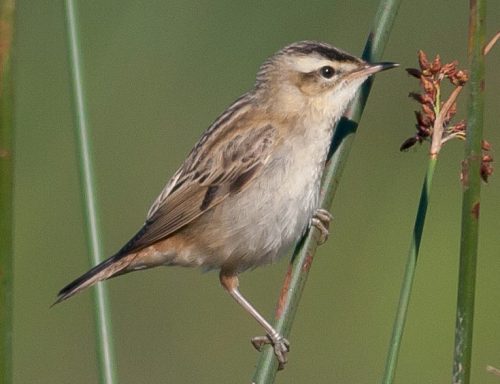
The Sedge Warbler, scientifically classified as Acrocephalus schoenobaenus, is designated as “Least Concern” in terms of conservation status. As a species of Old World warbler and a close relative of the Old World babbler family, these birds exhibit distinct features. Relatively small in size with a long beak, Sedge Warblers have a brown back, streaked wings, and a noticeable light supercilium.
Their rump is characterized by a warm brown color without spots, creating a contrast with the duller wings. Sedge Warblers possess a strong, pointed bill, a black crown with a streak of white, and a flattened forehead, contributing to their unique appearance.
The Sedge Warbler boasts an extensive population, spanning over 100 nations across three continents. During winter months, these birds can be found in wet grasslands and lowland rainforests. Conversely, their breeding grounds are situated in the lowlands and valleys of cooler climates near water.
With a length ranging from 4.5 to 5.1 inches (11.5–13 cm), a weight of 0.3–0.4 ounces (10–12 g), and a wingspan of 6.7–8.3 inches (17–21 cm), the Sedge Warbler has a potential lifespan of up to 2 years.
Rivoli’s Hummingbird
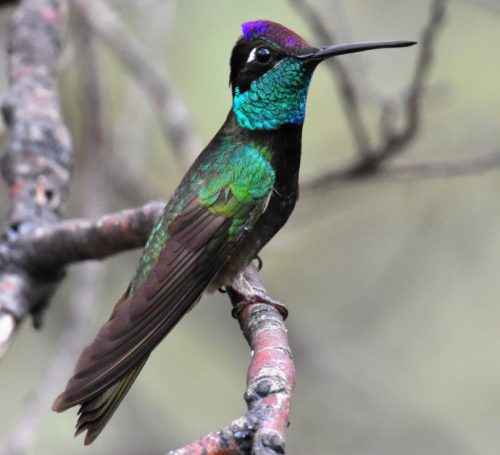
Rivoli’s Hummingbird, scientifically named Eugenes fulgens, holds a conservation status of “Least Concern” and is noteworthy for being one of the two largest species within the hummingbird family in the United States. Characterized by a long beak that can either be perfectly straight or slightly bent, these hummingbirds exhibit a dark appearance that transforms into vivid colors in the sunshine, a feature shared by both sexes.
Despite their larger size in comparison to other hummingbirds, Rivoli’s Hummingbirds display uncommonly gentle behavior, rarely harassing smaller birds at feeders or flower bushes. Instead, they engage in traplining, following a set path between widely spaced patches of flowers. At each stop along the way, they utilize their extremely long beaks to extract nectar.
During the winter months, these hummingbirds undertake migrations as far north as California from their year-round homes in Mexico and Central America. Birding lodges and bed-and-breakfast establishments in southeastern Arizona often feature hummingbird gardens designed to attract Rivoli’s Hummingbirds, providing optimal viewing opportunities during the spring and summer. With a length ranging from 4.3 to 5.5 inches (11–14 cm), a weight of 0.21–0.35 ounces (6–10 g), and a wingspan of 7–7.5 inches (17.8–19 cm), Rivoli’s Hummingbirds can live up to 8 years. Their distinctive characteristics and migratory patterns make them a captivating subject for bird enthusiasts, particularly during the warmer seasons in specific regions.
Lucifer Hummingbird
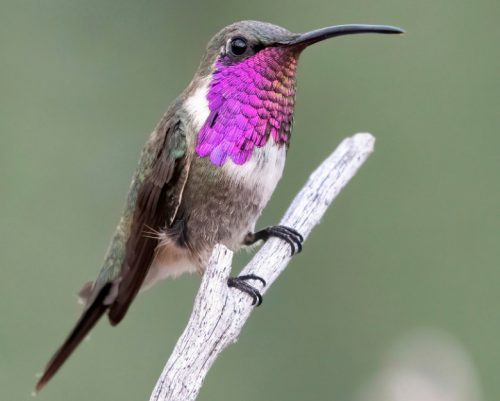
The Lucifer Hummingbird, scientifically known as Calothorax lucifer, is classified as “Least Concern” in terms of conservation status. Renowned for its vivid appearance and long beak, this hummingbird species is primarily found in the high mountain regions of northern Mexico and the southwestern United States. However, during the winter months, they undertake migration to central Mexico.
Distinguished by olive-green heads with white streaks behind their eyes and characteristic gorgets that flare outward, Lucifer Hummingbirds compensate for their small stature with a long curved beak, sharp claws, and a tail. As members of the sheartail genus of hummingbirds, their name is derived from the sharply forked and slender shape of their tails, making them highly coveted subjects for ornithologists.
The diet of Lucifer Hummingbirds consists mainly of bees, spiders, small insects, and nectar from agave and other vibrant desert flowers. Like most hummingbirds, they exhibit feeding behaviors such as snatching insects in midair, consuming flower nectar, and traveling in straight lines.
With a length ranging from 3.5 to 4 inches (9–10 cm), a weight of 0.10–0.11 ounces (2.7–3.3 g), and a wingspan of 4–4.3 inches (10–11 cm), Lucifer Hummingbirds have a potential lifespan of up to 5 years.
Calliope Hummingbird
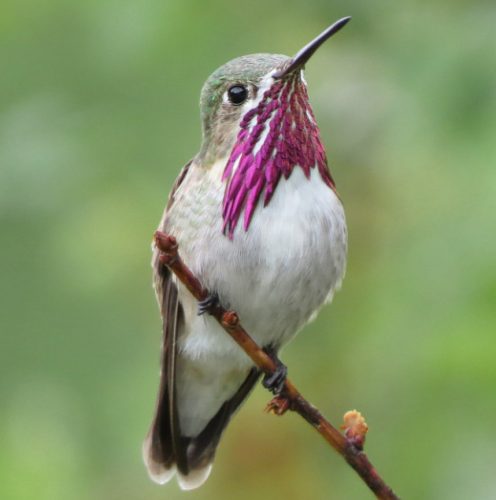
The Calliope Hummingbird, scientifically designated as Selasphorus calliope, holds a conservation status of “Least Concern” and is renowned as one of the smallest birds with long beaks in North America. Measuring approximately three inches in length and weighing around 0.1 ounces, this diminutive hummingbird species exhibits remarkable characteristics.
Formerly known as Little Star, the genus name has been changed to Calliope, inspired by the Greek muse, providing a fitting name for this captivating bird.
During mating season, the Calliope Hummingbirds are known to come together, with males engaging in fierce battles to protect their breeding and feeding grounds, sometimes resulting in fatal confrontations.
Active during the daytime, these hummingbirds can be observed perching or hovering above blooms, utilizing their long, flexible tongues to siphon nectar. They also showcase the ability to catch flying insects of a certain size.
Remarkably, some Calliope Hummingbirds migrate annually from Canada to southern Mexico, demonstrating their resilience in withstanding the cold summer evenings at high elevations in the northern Rockies.
With a length ranging from 2.7 to 4 inches (7–10 cm), a weight of 0.07–0.1 ounces (2–3 g), and a wingspan of 4.1–4.3 inches (10.5–11 cm), Calliope Hummingbirds can live up to 8 years.
Common Sandpiper
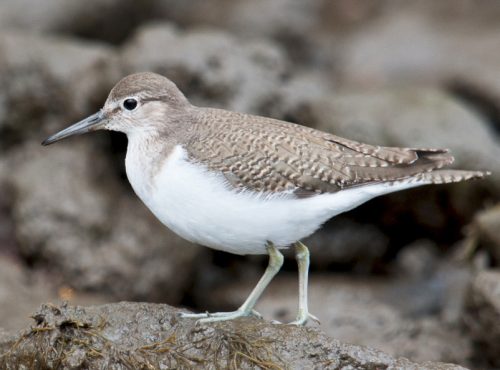
The Common Sandpiper, scientifically identified as Actitis hypoleucos, is classified as “Least Concern” in terms of conservation status. Despite its small size, this bird features a notably large beak and is characterized by brown plumage with white splotches on its back and tail.
As opportunistic feeders, Common Sandpipers rely on their keen eyesight to locate prey on land or in shallow water. Their long, slender beaks are well-suited for snatching insects and small fish, constituting the primary components of their diet. Additionally, they display sociable behavior, often traveling in large groups.
During the summer, Common Sandpipers are distributed across temperate and subtropical regions in Europe and Asia. In the winter, they migrate to warmer areas, including Africa, southern Asia, and Australia.
With a length ranging from 7 to 8 inches (18–20.5 cm), a weight of 1.4–2 ounces (41–56 g), and a wingspan of 12.6–13.8 inches (32–35 cm), Common Sandpipers have a potential lifespan of up to 10 years.
Common Redshank
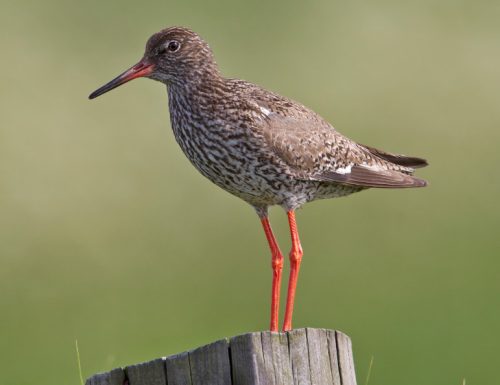
The Common Redshank, scientifically known as Tringa totanus, is classified as “Least Concern” in terms of conservation status. This small bird, distinguished by long legs and a lengthy beak, is distributed across various parts of Eurasia. Notably, the vibrant legs of the Common Redshank contribute to the origin of its name.
During the off-season, these birds exhibit a more rusty orange coloration, transforming into a vibrant crimson hue during the mating season. Notably, sightings of Common Redshanks in the Americas are officially considered vagrant occurrences.
Marked by vigilance and vocalization, these birds emit piping calls that serve as alerts to nearby wildlife. As carnivores, Common Redshanks have a diverse diet, encompassing insects, spiders, worms, and other arthropods. There are also reported instances of them consuming fish and tadpoles.
Migratory in nature, Common Redshanks spend their winter months along the Mediterranean coast, the Atlantic coast of Europe south of Ireland and Great Britain, and the shores of South Asia. With a length ranging from 9.4 to 10.6 inches (24–27 cm), a weight of 3.2–4.5 ounces (92–127 g), and a wingspan of 18.5–20.9 inches (47–53 cm), these birds can live up to 10 years.
Rufous-tailed Jacamar
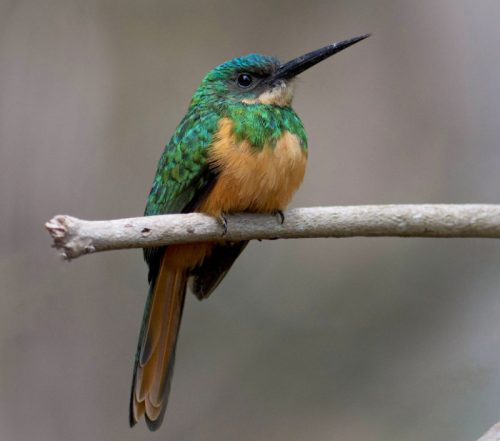
The Rufous-tailed Jacamar, scientifically known as Galbula ruficauda, holds a conservation status of “Least Concern.” This stunning bird is distinguished by its long, brilliantly colored tail and a curved beak. The metallic green color adorns the upper parts of the Rufous-tailed Jacamar, while the lower parts, including the undertails, exhibit a predominantly orange hue.
As insectivores, these birds employ a unique hunting technique. They perch, angle their bills upward, and then swoop down to collect insects in midair. Their diet primarily consists of various insects, including flies, beetles, bees, dragonflies, butterflies, and butterfly larvae. Remarkably, their ability to discern which butterflies are challenging to catch adds to their hunting prowess.
When in flight, the Rufous-tailed Jacamar showcases brilliant blue wings that stand out against the sky, contributing to their overall striking appearance.
These passerine bird species are widely distributed across most of Central and South America, including Mexico. They are commonly found in marshes and swamps, where their diet includes small crabs and insects. With a length ranging from 8.3 to 9.8 inches (21–25 cm), a weight of 0.9–1.1 ounces (25–33 g), and a wingspan of 9.8–12.2 inches (25–31 cm), the Rufous-tailed Jacamar has a potential lifespan of up to 7 years. The combination of their vibrant colors, unique hunting behavior, and diverse habitat preferences contributes to the fascination surrounding these avian species.
Plain-Capped Starthroat
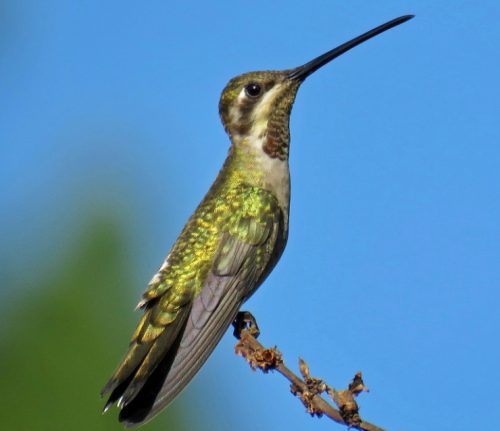
The Plain-capped Starthroat, scientifically identified as Heliomaster constantii, holds a conservation status of “Least Concern.” This small hummingbird species exhibits a brown coloration, characterized by a long, slender beak and a bronze-green tail adorned with white tips on the outer 3 to 4 pairs of feathers. Notably, their wingspan extends to the end of their tail.
These starthroats sustain themselves by consuming nectar from a diverse array of flowers, displaying a preference for sweet-smelling blooms. Their diet includes nectar, tiny insects obtained through hawking from an open perch, and foliage. Remarkably, they adeptly capture insects either in flight, plucking them from leaves or branches, or while entangled in spider webs.
Typically found in the arid forests of Mexico, the Plain-capped Starthroat has also been observed in Arizona. With a length ranging from 4.3 to 4.7 inches (11–12 cm), a weight of 0.25–0.28 ounces (7–8 g), and a wingspan of 5.1–7 inches (13–17.8 cm), this hummingbird species has a potential lifespan of up to 10 years.
Brown-headed Nuthatch
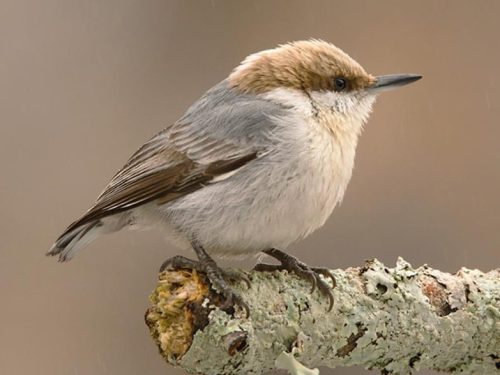
The Brown-headed Nuthatch, scientifically known as Sitta pusilla, is designated as “Least Concern” in terms of conservation status. This small bird, residing in the eastern United States, derives its name from the distinctive features of a black head and a white chest patch.
Measuring between 3.5 and 4.3 inches (9–11 cm) in length, with a weight ranging from 0.35 to 0.42 ounces (10–12 g) and a wingspan of 6.3–7.1 inches (16–18 cm), the Brown-headed Nuthatch has a potential lifespan of up to 8 years.
These nuthatches primarily forage for insects and wild berries at elevated positions in trees, occasionally incorporating seeds found in grass into their diet. Throughout the year, pairs of Brown-headed Nuthatches communicate with distinct calls from the treetops. The optimal habitat for spotting these birds is a mature pine forest in the Southeast with an open understory.
When exploring southern pine forest floors, the distinctive squeaky sound resembling a rubber ducky serves as an auditory cue to be on the lookout for these brown-headed birds.
American Woodcock
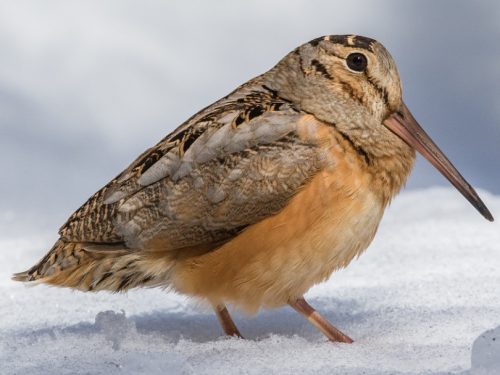
The American Woodcock, scientifically identified as Scolopax minor, is categorized as “Least Concern” in terms of conservation status. This distinctive bird, measuring between 9.8 and 11.8 inches (25–30 cm) in length, boasts an orange chest among its small brown features. Notably, the American Woodcock is characterized by a long beak reminiscent of rubber darts, aiding in its predilection for probing the soil for worms.
With a weight ranging from 5 to 8.1 ounces (140–230 g) and a wingspan of 16.5–18.9 inches (42–48 cm), the American Woodcock has a potential lifespan of up to 8 years.
Being insectivorous predators, American Woodcocks primarily feast on earthworms and a variety of invertebrates. Their diet encompasses insect eggs, larvae, snails, centipedes, millipedes, spiders, snipe flies, beetles, ants, and occasionally, some plant matter such as seeds.
These birds are well-adapted to navigating muddy and watery environments, thanks to their long legs. The distinctive feature of their long beak serves them well in their foraging endeavors.
To witness the American Woodcock’s captivating display flights, known as sky dances, one is more likely to encounter them during the spring sunset. During this time, males perform these aerial acrobatics, accompanied by their characteristic buzzy peent call, emitted at fairly short intervals.
Scarlet Myzomela
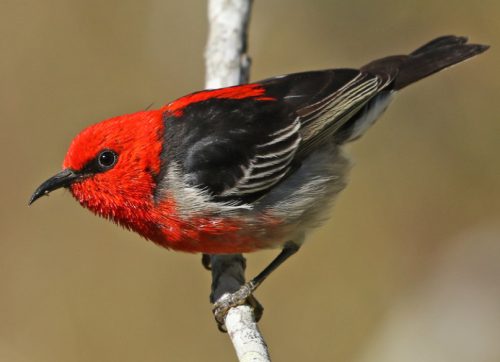
The Scarlet Myzomela, scientifically known as Myzomela sanguinolenta and also referred to as the Scarlet Honeyeater, is classified as “Least Concern” in terms of conservation status. Recognizable by its small size, short tail, long, downwardly curled black beak, and dark brown eyes, this species displays sexual dimorphism. Males exhibit a stunning brilliant red color with black wings, while females are characterized by a brown plumage.
Measuring between 3.5 and 4.3 inches (9–11 cm) in length, with a weight ranging from 0.28 to 0.31 ounces (8–9 g) and a wingspan of 7.1–7.5 inches (18–19 cm), the Scarlet Myzomela has a potential lifespan of up to 6 years.
Primarily nectarivores, these birds feed high in the canopy on flowers and leaves, occasionally consuming fruit and insects. They can be observed either solitarily or in small groups during feeding.
While the southern half of Australia sees a lower prevalence of Scarlet Myzomelas due to their status as summer migratory birds, they can be found from Cooktown, Queensland, to Gippsland, Victoria. Their habitat of choice includes open woodlands and forests with a well-developed understory, particularly near wetlands and occasionally in rainforests.
Hairy Woodpecker
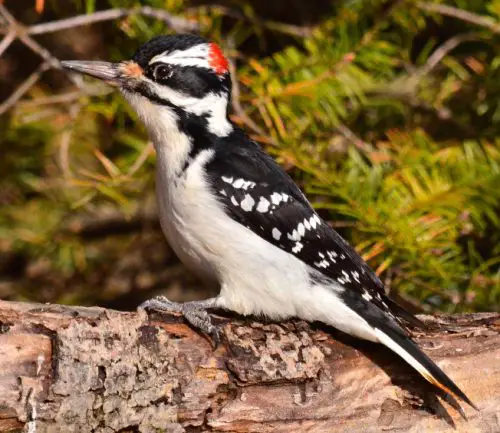
The Hairy Woodpecker, scientifically known as Leuconotopicus villosus and classified as “Least Concern” in terms of conservation status, is a small yet formidable bird capable of pecking through the trunks and major branches of enormous trees with its long beak.
Measuring between 7 and 10.2 inches (18–26 cm) in length, with a weight ranging from 1.4 to 3.4 ounces (40–95 g) and a wingspan of 13–17 inches (33–43 cm), the Hairy Woodpecker boasts a potential lifespan of up to 15 years.
When perched on a tree trunk, these woodpeckers assume an upright, straight-backed position, and their finely striped heads give them a distinctive and somewhat military appearance.
Indigenous to North America, Hairy Woodpeckers can be found from the coast to the highlands, spanning from California to Alaska. To locate them, observe for black and white birds with striking patterns on the trunks and main branches of large trees.
The energetic tapping sounds produced by Hairy Woodpeckers during their foraging activities serve as an auditory cue for their presence. The rhythmic drumming on wood is a characteristic behavior as they search for food.
Brown Creeper
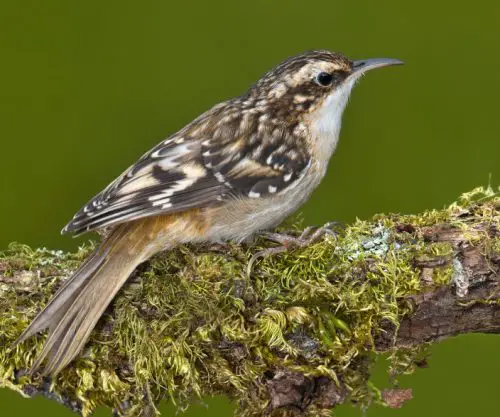
The Brown Creeper, scientifically known as Certhia americana and classified as “Least Concern” in terms of conservation status, is a small bird characterized by its long, pointed beak.
Measuring between 4.7 and 5.5 inches (12–14 cm) in length, with a weight ranging from 0.2 to 0.4 ounces (5–10 g) and a wingspan of 6.7–7.9 inches (17–20 cm), the Brown Creeper has a potential lifespan of up to 4 years.
Primarily found in the western United States, Brown Creepers inhabit wooded areas and forests. Their narrow, downward-curving beaks facilitate exploration of cracks and the peeling of bark for loose pieces, and they construct their hammock-shaped woven nests behind these bark layers.
Despite being common, Brown Creepers are often challenging to spot due to their inconspicuous nature. Their sharp sounds serve as helpful cues in locating them. During winter, these birds can be found in parks and suburbs, blending seamlessly with the bark of trees in gloomy woodland edges.
Brown Creepers are also observable in various regions, including Mexico, Arkansas, and the northern Gulf States.
Red Crossbill
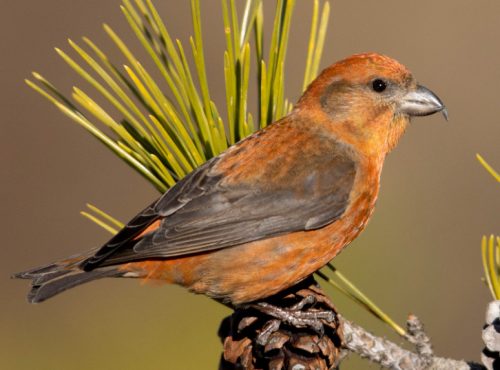
The Red Crossbill, scientifically known as Loxia curvirostra and classified as “Least Concern” in terms of conservation status, is a distinctive bird recognized by its red head patch and a uniquely crossed beak evolved for extracting seeds from pine cones.
Measuring between 5.5 and 6.3 inches (14–16 cm) in length, with a weight ranging from 1.1 to 1.5 ounces (31–42 g) and a wingspan of 9.8–10.6 inches (25–27 cm), the Red Crossbill has a potential lifespan of up to 8 years.
A notable feature of the Red Crossbill is the adaptation in its beak. The long tips of their upper and lower beaks do not meet; instead, they cross over each other. This crossed beak allows them to efficiently bite between the scales of a cone, prying them apart by opening their beaks and then dislodging the seeds with their tongues.
Throughout the year, small flocks of Red Crossbills are frequently observed. They are commonly found in old-growth coniferous forests, where they utilize their feet and bills to ascend to the tops of trees in search of conifer cones. Interestingly, if the cone yield is substantial, they may engage in breeding during the winter.
Common Kingfisher
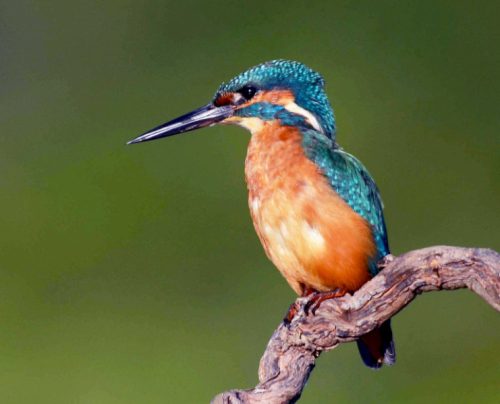
The Common Kingfisher, scientifically known as Alcedo atthis and categorized as “Least Concern” in terms of conservation status, is a near-passerine bird widely distributed across North and South America, Europe, Australia, and Africa. Recognizable by its distinctive long beak, the Kingfisher exhibits sexual dimorphism, with males possessing short, dark beaks, and females having long, black beaks with a red patch at the base. They boast coppery brown to orange breasts and a brilliant metallic blue back.
Measuring between 6.3 and 6.7 inches (16–17 cm) in length, with a weight ranging from 0.92 to 1.37 ounces (26–39 g) and a wingspan of 9.5–10 inches (24–26 cm), the Common Kingfisher has a potential lifespan of up to 15 years.
Known for their exceptional fishing skills, Kingfishers utilize their long beaks to dive for prey, including minnows and dragonfly nymphs. These birds are commonly found in areas with calm currents, perching on low-hanging branches or poles near the water’s edge, patiently waiting to make their swift dives for food.

